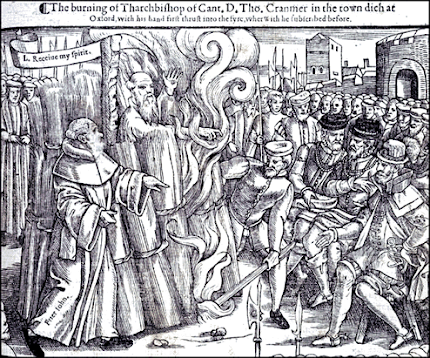After Cranmer's death, most of these churches would be
labelled 'Calvinist' or 'Reformed'. He would not have recognised these
descriptions, but if he had lived, it is very likely that he would have
done his best to take the English church in the same direction. -- Diarmaid MacCullough
Diarmaid MacCulloch reflects on the 'after-life'
of Henry VIII's archbishop, burnt at the stake as a Protestant martyr
under Mary.
 Portrait of Cranmer after Henry VIII's death by an unknown artistArchbishop
Thomas Cranmer died at the stake in 1556, a martyr for the English
Reformation; but did he die a martyr for the Church of England or for
Anglicanism? If we examine Cranmer's career after he parted company in
the early 1530s with the Catholicism of his first forty years, we find a
man of international perspective, who sought to move England into the
path of the wider European Reformation: in particular towards the
Reformations to be found in the churches of south Germany and
Switzerland. After Cranmer's death, most of these churches would be
labelled 'Calvinist' or 'Reformed'. He would not have recognised these
descriptions, but if he had lived, it is very likely that he would have
done his best to take the English church in the same direction.
Portrait of Cranmer after Henry VIII's death by an unknown artistArchbishop
Thomas Cranmer died at the stake in 1556, a martyr for the English
Reformation; but did he die a martyr for the Church of England or for
Anglicanism? If we examine Cranmer's career after he parted company in
the early 1530s with the Catholicism of his first forty years, we find a
man of international perspective, who sought to move England into the
path of the wider European Reformation: in particular towards the
Reformations to be found in the churches of south Germany and
Switzerland. After Cranmer's death, most of these churches would be
labelled 'Calvinist' or 'Reformed'. He would not have recognised these
descriptions, but if he had lived, it is very likely that he would have
done his best to take the English church in the same direction.Read the rest of the article here: Cranmer's Ambiguous Legacy | History Today




No comments:
Post a Comment